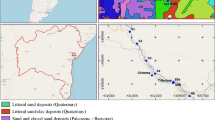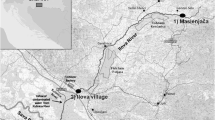Abstract
Although metallic mineral resources are most important in the economy of Mongolia, mining activities with improper management may result in the pollution of stream waters, posing a threat to aquatic ecosystems and humans. In this study, aiming to evaluate potential impacts of metallic mining activities on the quality of a transboundary river (Selenge) in central northern Mongolia, we performed hydrochemical investigations of rivers (Tuul, Khangal, Orkhon, Haraa, and Selenge). Hydrochemical analysis of river waters indicates that, while major dissolved ions originate from natural weathering (especially, dissolution of carbonate minerals) within watersheds, they are also influenced by mining activities. The water quality problem arising from very high turbidity is one of the major environmental concerns and is caused by suspended particles (mainly, sediment and soil particles) from diverse erosion processes, including erosion of river banks along the meandering river system, erosion of soils owing to overgrazing by livestock, and erosion by human activities, such as mining and agriculture. In particular, after passing through the Zaamar gold mining area, due to the disturbance of sediments and soils by placer gold mining, the Tuul River water becomes very turbid (up to 742 Nephelometric Turbidity Unit (NTU)). The Zaamar area is also the contamination source of the Tuul and Orkhon rivers by Al, Fe, and Mn, especially during the mining season. The hydrochemistry of the Khangal River is influenced by heavy metal (especially, Mn, Al, Cd, and As)-loaded mine drainage that originates from a huge tailing dam of the Erdenet porphyry Cu-Mo mine, as evidenced by δ34S values of dissolved sulfate (0.2 to 3.8 ‰). These two contaminated rivers (Tuul and Khangal) merge into the Orkhon River that flows to the Selenge River near the boundary between Mongolia and Russia and then eventually flows into Lake Baikal. Because water quality problems due to mining can be critical, mining activities in central northern Mongolia should be carefully managed to minimize the transboundary movement of aquatic contaminants (in particular, turbidity, dissolved organic carbon, Fe and Al) from mining activities.






Similar content being viewed by others
References
APHA, AWWA, WEF (1995) Standard methods for the examination of water and wastewater, 19th edn. APHA Publications, Maryland
Appelo CAJ, Postma D (1996) Geochemistry, groundwater and pollution, 3rd edn. Balkema, Rotterdam/Brookfield
Baljinnyam N, Frontasyeva MV, Aleksiayenak YV (2014) INAA for determination of trace elements in bottom sediments of the Selenga river basin in Mongolia. Phys Particles and Nuclei Lett 11:199–208. doi:10.1134/S1547477114020149
Batbayar B, Karthe D, Pfeiffer M, von Tűmpling W, Kappas M (2015) Influence of urban settlement and mining activities on surface water quality in northern Mongolia, Water and environment in the Selenga-Baikal basin. International Research Cooperation for an Ecoregion of Global Relevance. ISSN 1614-4716
Battogtokh B, Lee JM, Woo N (2014) Contamination of water and soil by the Erdenet copper-molybdenum mine in Mongolia. Environ Earth Sci 71:3363–3374
Berner EK, Berner RA (1987) The global water cycle, geochemistry and environment. Prentice-Hall, Upper Saddle River 397 pp
Borah DK, Bera M, Shaw S (2003) Water, sediment, nutrient, and pesticide measurements in an agricultural watershed in Illinois during storm events. Trans ASAE 46:657–674
Calder IR (1992) Hydrologic effects of land-use change. In: Maidment DR (ed) Handbook of hydrology. McGraw-Hill, USA
Chae GT, Yun ST, Kim KH, Lee PK, Choi BY (2004) Atmospheric versus lithogenic contribution to the composition of first- and second-order stream waters in Seoul and its vicinity. Environ Int 30:73–85
Chalov SR (2014) Effects of placer mining on suspended sediment budget: case study of north of Russia’s Kamchatka Peninsula. Hydrol Sci J 59:1–14
Chalov SR, Jarsjo J, Kasimov NS, Romanchenko AO, Pietroń J, Thorslund J, Promakhova EV (2015) Spatio-temporal variation of sediment transport in the Selenga River Basin, Mongolia and Russia. Environ Earth Sci 73:663–680
Choi J, Badarch M, Lee J, Lee YJ, Badarch EO (2004) Project report on joint pilot studies between Korea and Mongolia on assessment of environmental management system in gold mining industry of Mongolia (I). Korea Environment Institute, Seoul 107 pp
Dalai B, Ishiga H (2013) Geochemical evaluation of present-day Tuul River sediments, Ulaanbaatar basin, Mongolia. Environ Monit Assess 185:2869–2881
Davaa G, Odgarav J (2012) Tuul River. In: Chikamori H, Liu H, Daniell T (eds), Catalogue of rivers for Southeast Asia and the Pacific, Vol. VI UNESCO-IHP Regional Steering Southeast Asia and the Pacific Committee for Southeast Asia and the Pacific
Falkner KK, Church M, Measures CI, LeBaron G, Thouron D, Jeandel C, Stordal MC, Grill GA, Mortlock R, Froelich P, Chan LH (1997) Minor and trace element chemistry of lake Baikal, its tributaries, and surrounding hot springs. Limnol Oceanogr 42:329–345
Fitzhugh RD, Furman T, Korsak AK (2001) Sources of stream sulphate in head-water catchments in Otter Creek Wilderness, West Virginia, USA. Hydrol Process 15:541–556
Gerel O, Munkhtsengel B (2005) Erdenetiin Ovoo porphyry copper-molybdenum deposit in northern Mongolia. In: Porter TM (ed) Super porphyry copper and gold deposits: a global perspective, vol 2. PGC Publishing, Adelaide, pp. 525–554
Götz R, Enge P, Friesel K, Roch K, Kjeller LO, Kulp SE, Rappe C (1994) Sampling and analysis of waters and suspended particulate matter of the River Elbe for polychlorinated dibenzo-p-dioxins (PCDDs) and dibenzofurans (PCDFs). Chemosphere 28:63–74
Granina LZ, Callender E, Grachev AM, Grachev MA (1998) Input of particulate elements with riverine waters into Lake Baikal and their role in chemical balance (Ti, Cr, Sr, Cu, Zn, Pb, Br). Doklaly RAN 362:391–395 (in Russian)
Hartwig M, Theuring P, Rode M, Borchardt D (2012) Suspended sediments in the Kharaa River catchment (Mongolia) and its impact on hyporheic zone functions. Environ Earth Sci 65:1535–1546
Hatje V, Rae K, Birch GF (2001) Trace metal and total suspended solids concentration I freshwater: the importance of small-scale temporal variability. J Environ Monit 3:251–256
Hofmann J, Venohr M, Behrendt H, Opitz D (2010) Integrated water resources management in central Asia: nutrient and heavy metal emissions and their relevance for the Kharaa River Basin, Mongolia. Water Sci Technol 62:353–363
IMF (International Monetary Fund) (2015) IMF country report no. 15/109 (2015 article IV consultation staff report, press release, and statement by the executive director for Mongolia). IMF, Washington DC
JAICA (Japan International Cooperation Agency) (2003) Project report “action research on mercury pollution in Boroo area, Mongolia”. JAICA, Japan 37 pp
JAICA (Japan International Cooperation Agency) (2006) Project report “the river basin management model project for the conservation of wetland and ecosystem and its sustainable use in Mongolia, pre-evaluation survey report”. JAICA, Japan 21 pp
Karpoff BS, Roscoe WE (2005) Report on placer gold properties in the Tuul Valley, Zaamar Goldfield, Mongolia. Roscoe Postle Associates Inc, Canada 67 pp
KEI (Korea Environment Institute) (2006) Project report on “joint research between Korea and Mongolia on water quality and contamination of transboundary watershed in northern Mongolia”. KEI, Seoul 61 pp
KEI (Korea Environment Institute) (2008) Project report on “integrated water management model on the Selenge River basin status survey and investigation (phase I)”. KEI, Seoul 419 pp
Kelderman P, Batima P (2006) Water quality assessment of rivers in Mongolia. Water Sci Technol 53:111–119
Kendall C (1998) Tracing nitrogen sources and cycling in catchments. In: Kendall C, McDonnell JJ (eds) Isotope tracers in catchment hydrology. Elsevier, Amsterdam, pp. 521–576
Kirk JTO (1994) Light and photosynthesis in aquatic ecosystems, 2nd edn. Cambridge University Press, NY
Krouse HR, Mayer B (2000) Sulphur and oxygen isotopes in sulphate. In: Cook PG, Herczeg AL (eds) Environmental tracers in subsurface hydrology. Kluwer Academic, Dordrecht, pp. 195–231
Li SG, Asanuma J, Kotani A, Davaa G, Oyunbaatar D (2007) Evapotranspiration from a Mongolian steppe under grazing and its environmental constraints. J Hydrol 333:133–143
Luis AT, Teixeira P, Almeida SFP, Matos JX, Silva EF (2011) Environmental impact of mining activities in the Lousal area (Portugal): chemical and diatom characterization of metal contaminated stream sediments and surface water of Corona stream. Sci Tot Environ 409:4312–4325
Meybeck M, Chapman D, Helmer R (1989) Global freshwater quality: a first assessment. Blackwell, Oxford 307 pp
Munkhtsengel B, Ohara M, Gerel O, Dandar S, Tsuchiya N (2006) Preliminary study of formation mechanism of the Erdenetiin Ovoo porphyry copper-molybdenum deposit and environmental effects of Erdenet mine, northern Mongolia. Proceedings of CP833, Water Dynamics: 3rd International Workshop on Water Dynamics, pp 204–207
Nadmitov B, Hong S, Kang SI, Chu JM, Gomboev B, Janchivdorj L, Lee CH, Khim JS (2015) Large-scale monitoring and assessment of metal contamination in surface water of the Selenga River Basin (2007–2009). Environ Sci Pollut Res 22:2856–2867
Pfeiffer M, Batbayar G, Hofmann J, Siegfried K, Karthe D, Hahn-Tomer S (2015) Investigating arsenic (As) occurrence and sources in ground, surface, waste and drinking water in northern Mongolia. Environ Earth Sci 73:649–662
Pietroń J, Jarsjo J, Romanchenko AO, Chalov SR (2015) Model analyses of the contribution of in-channel processes to sediment concentration hysteresis loops. J Hydrol 527:576–589
Piper AM (1944) A graphical procedure in the geochemical interpretation of water-analyses. Am Geophys Union Trans 25:914–923
Priess JA, Schweitzer C, Batkhishig O, Koschitzki T, Wurbs D (2015) Impacts of agricultural land-use dynamics on erosion risks and options for land and water management in Northern Mongolia. Environ Earth Sci 73:697–708
Semenova BA, Myagmarjav B (1977) Hydrological regime of the Selenge river basin, Leningrad
Shinkareva GL, Kasimov NS, Lychagin MY (2015) Heavy metal fluxes in the rivers of the Selenga basin, water and environment in the Selenga-Baikal basin. International Research Cooperation for an Ecoregion of Global Relevance. ISSN 1614-4716
Stubblefield A, Chandra S, Eagan S, Tuvshinjargal D, Davaadorzh G, Gilroy D, Sampson J, Thorne J, Allen B, Hogan Z (2005) Impacts of gold mining and land use alterations on the water quality of central Mongolian rivers. Integr Environ Assess Manag 1:365–373
Takahashi Y (2004) Introduction to geology of Mongolia based upon GIS. Geological Society of Japan (GSJ) Open File, no. 413
Tarras-Wahlberg NH (2002) Environmental management of small-scale and artisanal mining: the Portovelo-Zruma gold mining area, southern Ecuador. J Environ Manag 65:165–179
Thorslund J, Jarsjo J, Chalov SR, Belozerova EV (2012) Assessment of the gold mining impact on riverine heavy metal transport in a sparsely monitored region: the upper Lake Baikal Basin case. J Environ Monit 14:2780–2792
Thorslund J, Jarsjő J, Wällstedt T, Mőrth CM, Lychagin MY, Chalov SR (2016) Speciation and hydrological transport of metals in non-acidic river systems of the Lake Baikal basin: field data and model predictions. Reg Environ Change (in press). doi:10.1007/s10113-016-0982-7
Tomurtogoo O, Byamba J, Badarch G, Minjin C, Orolmaa D, Khosbayar P, Chuluun D (1998) Geologic map of Mongolia, scale 1:1, 000, 000 and summary. Mineral Resources Authority of Mongolia, Ulaanbaatar
Tugarinov AI, Voinkov DM, Grinenko LN, Pavlenko AS (1974) Isotopic composition and sources of molybdenum-copper mineralization of Mongolia. Geochemistry 2:173–178 (in Russian)
USAWorld Bank (2006) The Mongolia: a review of environmental and social impacts in the mining sector. http://www.worldbank.org/eapenvironment
Vondracek B, Zimmerman JKH, Westra JV (2003) Setting an effective TMDL: sediment loading and effects of suspended sediment on fish. J Am Water Resour Assoc 39:1005–1015
Walters RW, Ostazeski SA, Guiseppi-Elie A (1989) Sorption of 2,3,7,8-tetrachlorodibenzo-p-dioxin from water by surface soils. Environ Sci Technol 23:480–484
Wetzel RG (2001) Limnology: lake and river ecosystems, 3rd edn. Academic Press, Cambridge
Ziadat AH, Jiries A, Berdanier B, Batarseh M (2015) Bio-monitoring of heavy metals in the vicinity of copper mining site at Erdenet, Mongolia. J Appl Sci 15(11):1297–1304
Acknowledgments
This work was initially supported by Korea Environment Institute (KEI) as the Korea-Mongolia collaboration project “Joint Research Between Korea and Mongolia on Water Quality and Contamination of Transboundary Watershed in Northern Mongolia.” Mr. Ochirsukh Ayur (Mongolian Nature and Environment Consortium) helped us in field surveys. The preparation of this manuscript was supported by KEITI through the Korea CO2 Storage Environmental Management (K-COSEM) Research Center.
Author information
Authors and Affiliations
Corresponding authors
Additional information
Responsible editor: Stuart Simpson
Electronic supplementary material
ESM 1
(DOC 1079 kb)
Rights and permissions
About this article
Cite this article
Batsaikhan, B., Kwon, JS., Kim, KH. et al. Hydrochemical evaluation of the influences of mining activities on river water chemistry in central northern Mongolia. Environ Sci Pollut Res 24, 2019–2034 (2017). https://doi.org/10.1007/s11356-016-7895-3
Received:
Accepted:
Published:
Issue Date:
DOI: https://doi.org/10.1007/s11356-016-7895-3




